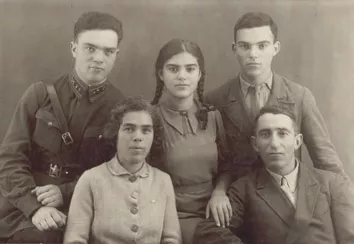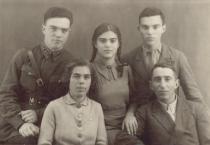Malea Veselnitskaya and her family
This is my family. My mother Dina Ostrovskaya and my father Isaac Ostrovski are sitting in front. Standing from left to right: my older brother Semyon, I, Malea Veselnitskaya, and my younger brother Ruvim. This photo was taken in Kremenchug in 1939. It was taken when my older brother Semyon returned home after finishing an artillery school in Leningrad. My mother is wearing a blouse that she borrowed from her relative, I am wearing a dress that I borrowed from our acquaintances' daughter, my father is wearing his friend's jacket and only Ruvim has his own jacket on.
In late 1933 our family moved to Kremenchug. It was easier to get a job in an industrial town. Father was assistant accountant in the Communtrans organization: it was an equipment yard of the town keeping transportation vehicles, snow ploughs, etc. In the morning father wished us a good day and left for a day. He was reserved and never punished us while mother could even slap us when necessary. If father ever felt like punishing any of us we began running around the table and he was chasing us until he burst into laughing. Our father was interested in politics. He wanted to join the Party, but mother was against it. She said if he did he would have to attend their meetings and stay away from home for a long time. Our parents didn't have many clothes. Father wore his work uniform. Mother had few sateen and cambric dresses and one woolen gown. She didn't wear a kerchief. She had curly hair. Our parents observed kashrut, but we didn't strictly observe all religious rules in our family. Father and mother went to the synagogue on holidays. They didn't take children to the synagogue and didn't force us to fast on Day of Atonement [Yom Kippur]. Our parents spoke Yiddish to one another and Russian to us.
When I went to school in Kremenchug in 1934, Ruvim was in the 4th form and Semyon was in the 8th form of a Russian school. Ruvim and I had classes in the 1st shift and Semyon went to school in the 2nd shift. In the evening we did our homework sharing one desk. Mother went to work as a cook in the school diner. She didn't have time to cook at home any more. Semyon got up early in the morning, set the stove and made mashed potatoes or even dumplings. When Ruvim and I came home from school there was lunch waiting for us wrapped in a blanket and tucked in with pillows to stay warm.
My mother was kind and cheerful and many people in Kremenchug knew about her culinary talents. When in 1936 a congress of Stakhanovites took place in Kremenchug [when workers were offered incentives to simplify and reorganize work process], they invited my mother to cook gefilte fish for them. The fish was so delicious that Stakhanovites [a miner who organized the event], began to lift up mother. Our neighbor children and children from other neighborhoods came to try 'full-dressed potatoes' - boiled unpeeled potatoes - that she made for all.
I wasn't an outstanding pupil considering my studies; we didn't have manual books. I had beautiful handwriting and I wrote on the blackboard what other pupils had to rewrite into their notebooks. A Russian girl Nina was my best friend. We had parties at school. I remember a carnival on New Year. Our neighbor Nyura gave me pants, a blouse, a guise and a cap from the circus where her husband and mother-in-law worked. My classmates and neighbor children had better clothes than I. It was particularly bad with footwear. Once I cried sitting on the porch on 30 April 1939 since I didn't have shoes to wear on the parade on 1 May. We didn't have any money since there was another delay with my father's salary. Our neighbor discovered what the problem was and lend my mother 10 rubles. My mother and I went to the department store where my mother bought me white canvas shoes with blue, yellow and red laces. I rubbed tooth powder to keep them white and this powder left white tracks when I walked. These shoes were only to be work for special occasion. In summer I walked barefooted in the yard. In winter I wore gray thick woolen boots with galoshes and a coat with artificial fur collar. In summer I wore a sateen dress. My mother made me a fancy cambric dress from her blouse and a vest - 'kazakinchik' that was in fashion, from another blouse.
















